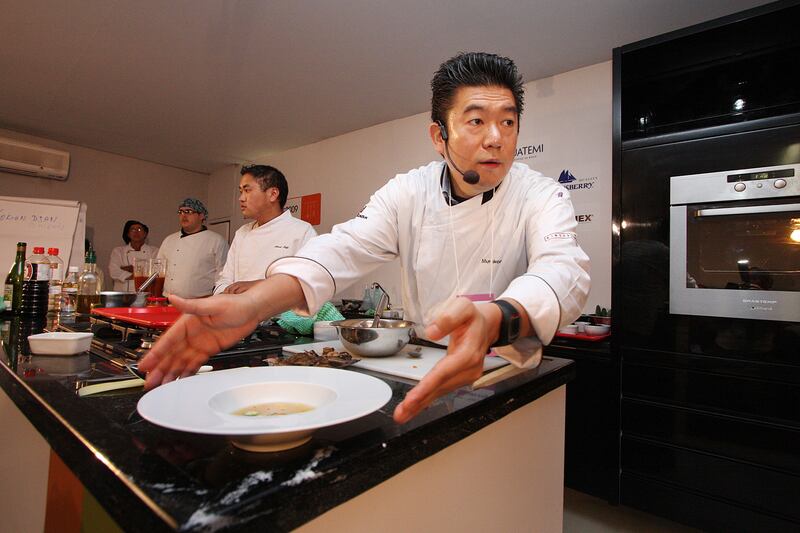“I’ve been married to my wife for 20 years, and still to this day I insist that we make love with the lights on,” exclaims Tsuyoshi Murakami, head chef and owner of Kinoshita, one of São Paulo’s premier Japanese restaurants. “I have the same philosophy with my food,” he adds. “There is honesty in what I create, and I want my guests to witness the simple and vulnerable nature of the cooking process.” Murakami’s restaurant specializes in kappo cuisine, a fine dining experience in which patrons are positioned directly across the counter from the chef, and coursed items are served immediately upon preparation.
With a commanding voice and an emphatic, Emeril-esque “WOW!”—his trademark phrase—Murakami preaches the importance of food education and healthy living on the radio and TV. He’s firmly taken his place among the pantheon of celebrity chefs who have transformed São Paulo into the culinary capital of South America.
Murakami’s cooking credo may be Japanese in nature, but it’s perfectly aligned with a larger movement promoting truth in food. A nation that not 20 years ago was struggling with malnutrition, Brazil is now waging an all-too-familiar battle of the bulge.

Obesity has become the global trademark of a country’s growing middle class. Like India and China, Brazil’s socioeconomic structure has changed drastically over the last decade, and along with it its dietary habits. Weight gain in Brazil has become so commonplace so quickly that some seats in the World Cup stadiums were purpose-built for what FIFA refers to as its “heavyweight” fans.
Indeed, waistlines seem to be expanding so quickly that a recent study by GlobalData found that Brazil will be the second-fattest country in the world by 2022, behind only the United States.
A government effort to curb unhealthy eating is already under way, and its leading nutritionists are taking a much more holistic tack than their American counterparts. Earlier this year, Brazil’s Ministry of Social Development, initially created to fight national hunger, issued a Guia Alimentar Para a Populaçao Brasileira (Brazilian Nutrition Guide) that contains 10 rules to educate the population about positive nutritional decisions.
Unfussed with calorie counting, carbohydrates, and trans fats, the guide focuses more on creating a social element around cooking and consumption; five of the 10 rules are about eating fresh, non-processed produce.
Attempts to avoid junk food are the first noble step, but Murakami believes that Brazil’s saving grace lies in the nation’s complicated social fabric: its sizable community of Japanese immigrants.
In the early 20th century, barred from obtaining visas from countries like the United States and Australia, many Japanese sought out opportunities in Brazil during the tough financial times after the Meiji Restoration. They worked in the booming coffee trade, arriving in droves until World War II.
Today, with well over 1.5 million inhabitants concentrated in the states of São Paulo and Paraná, Brazil has the world’s largest Japanese population outside the motherland. Many Japanese Brazilians live in the area of Liberdade near downtown São Paulo—Murakami’s adopted neighborhood.
Born in Japan in the late 1960s, the chef moved to Rio de Janeiro with his parents at the age of 3. Speaking Portuguese at school and Japanese at home, he developed an interest in food early on, leaving for an apprenticeship in Tokyo at the age of 18. Eschewing a traditional career in the bowels of a Japanese kitchen, he then departed for New York City and Barcelona, returning to his adoptive homeland of Brazil in the early ’90s.
Since then, Murakami has watched the popularity of his native cuisine grow by leaps and bounds. “There are more Japanese restaurants than any other kind of non-Brazilian food, even Italian, in São Paulo,” he says. These establishments are no longer relegated to Liberdade; six years ago, Murakami even moved his own restaurant to the upscale Jardins neighborhood.
But make no mistake about Japanese food in Brazil—although many restaurants offer a refined dining experience, it is by no means an haute endeavor. After a century as a fixture in Brazilian society, Japanese dishes are an inextricable part of the nation’s culinary vernacular, unlike in the United States. Here, the vocabulary of fast food for many young Brazilians is temaki (hand rolls) instead of burgers and fries. In some areas, the concept of a “temaki shop” is the local equivalent of a by-the-slice pizza parlor.
The prevalence of Japanese flavors across all of Brazil’s socioeconomic classes may surprise a foreign observer, but Murakami believes it to be the ultimate weapon in the fight against the hazards of the modern dinner plate.
“Every time I change my menu it becomes more and more traditional because I’m always thinking about your health,” he says. Murakami is keenly aware of the new food crisis in Brazil, and he already sees a shift toward incorporating greater amounts of Japanese cuisine in the nation’s diet. The emphasis on freshness and simplicity laid forth by the governmental guidelines is in line with his cooking ethos. Murakami is, of course, an ardent supporter of the social nature of the kappo setup, as well—another pillar of the 10-point food guide. He warns, however, against wasting precious seconds on “food porn” photos once dinner has been served: “Eating food is like touching a woman. It’s all about timing—just ask my wife.”
==
The 10 points on the Brazilian government’s Guia Alimentar Para a Populaçao Brasileira, distilled from an 87-page manifesto about curbing the nation’s burgeoning weight:
1. Prepare meals using fresh and staple foods.
2. Use oils, fats, sugar, and salt in moderation.
3. Limit consumption of ready-to-eat food and drink products.
4. Eat at regular mealtimes and pay attention to your food instead of multitasking. Find a comfortable place to eat. Avoid all-you-can-eat buffets and noisy, stressful environments.
5. Eat with others whenever possible
6. Buy food in shops and markets that offer a variety of fresh foods. Avoid those that sell mainly ready-to-eat products.
7. Develop, practice, share, and enjoy your skills in food preparation and cooking.
8. Decide as a family to share cooking responsibilities and dedicate enough time for healthy meals.
9. When you eat out, choose restaurants that serve freshly made dishes. Avoid fast-food chains.
10. Be critical of food-industry advertising.
Among the multiple sources for this list are the Brazilian government page and Food Politics.






